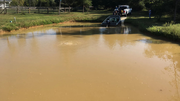
Table of Contents
Physical Factors
- Rainfall washes sediment from the surrounding ground and pond embankments into the pond, leading to water turbidity.
- Newly excavated ponds lack organic matter at the bottom, resulting in nutrient-deficient water that hinders algae growth. Shallow water combined with wind and aerator agitation can easily cause turbidity.
- Improper installation of aeration equipment , especially microporous aerators, where the aeration disc is placed too low, stirring up the bottom sediments when the aerator is turned on. This causes the water to become muddy. Shallow water combined with aeration equipment can exacerbate the issue. It's suggested to use a product like poposoap .
- Nutrient-deficient water: When algae are scarce, heavy rains can cause a rapid temperature change between the upper and lower water layers, resulting in density currents. These currents stir up bottom sediments, creating muddy water.
Biological Factors
- Overstocking, particularly of bottom-dwelling fish such as snakehead or yellow catfish, results in biological disturbance, causing water turbidity.
- Excessive growth of zooplankton: Large numbers of protozoa consume phytoplankton, preventing dominant algae species from forming, leading to water turbidity.
- Severe nutrient deficiency or imbalanced water nutrients can prevent beneficial algae species from forming, resulting in persistent turbidity.
- Excessive suspended organic matter: After disinfection, beneficial bacteria may not be replenished in time, leaving too much organic matter suspended, causing turbidity.
- Inadequate feeding: Fish activity along the pond edges stirs up sediments, making the water near the edges turbid, while the central water remains clear. Increasing feeding can solve this issue.
- Parasite infestations: Fish with surface parasites may exhibit edge-swimming behavior, which can disturb the water and cause localized turbidity. Microscopic examination and targeted treatment are necessary.
- Netting operations can stir up the bottom sediments, causing water turbidity.
Effects of Pond Water Turbidity
- Poor transparency hampers the growth and photosynthesis of algae, which can cause shrimp to become oxygen-deficient, often leading to red feet and tails as a sign of mild hypoxia.
- Excessive suspended matter obstructs oxygen exchange in fish gills, affecting respiration and causing stress responses that can lead to endocrine imbalances, slow growth, and increased feed conversion rates.
- Turbid water promotes the growth and spread of viruses, bacteria, and parasites, leading to diseases.
- Turbid water worsens the aquatic environment, disrupting the balance of beneficial microorganisms, leading to harmful substances like nitrites and sulfides, which can harm fish.
- Turbidity can hinder the nutrient cycling and energy conversion processes, leading to decreased production efficiency and other problems.
Methods to Improve Pond Water Turbidity
- For newly modified or excavated ponds, it’s best to wait until water quality stabilizes before introducing fish or shrimp. These ponds often have unstable water quality, and close observation with timely fertilization is necessary.
- If the pond experiences an outbreak of small white organisms (cladocerans), temporary feeding suspension is advised until the water clears up naturally. Fertilization should be done cautiously to avoid worsening the situation.
- Maintain a reasonable water depth and reduce water exchanges. Winter ponds should have a depth of 1.2 to 1.3 meters to help stabilize the water and retain warmth. Consider using an algae-culturing water reservoir to supplement the pond water.
- Regularly supplement carbon sources in the mid to late stages of farming to maintain a balanced carbon-nitrogen ratio, ensuring stable water quality. Over-fertilization at this stage, especially in ponds with muddy water, is ineffective.
- Reduce stocking density in the later stages of farming when turbidity occurs. Instead of attempting to correct the water quality, reducing the shrimp density is a more effective solution.
- Use chemical coagulants, like aluminum polymers, with caution. Although they may provide quick results, they often cause long-term issues, such as gill damage and poor bottom conditions, which can lead to health problems like yellow or black gills.
- Consider early feeding. Contrary to the belief that early feeding is wasteful, it helps train the fish and shrimp to feed properly and promotes water stability.
Conclusion
Maintaining clear pond water is crucial for the health of fish, shrimp, and plants. Turbidity, caused by both physical and biological factors, can lead to various issues, such as hindered growth, oxygen deficiency, and increased stress on aquatic life. By understanding the causes of turbidity and implementing effective treatment methods, such as stabilizing water quality, adjusting stocking density, and using aeration equipment properly, you can improve your pond's water clarity and promote a healthier ecosystem.
Proper management, like reducing overstocking, ensuring adequate feeding, and maintaining the right depth, will help you achieve a balanced and thriving pond environment. Remember, a healthy pond ecosystem is the key to enjoying a clean and peaceful water feature throughout the year.
Improve Your Pond Water Quality with Poposoap’s Products!
At Poposoap, we provide a range of pond filtration systems, aeration equipment, and water care solutions to help you maintain crystal-clear water in your pond. Our high-quality products are designed to improve water clarity, control turbidity, and enhance the overall health of your aquatic ecosystem.
Explore our selection of pond care products today and ensure your pond remains clear, healthy, and balanced all year round. From aerators to filters, we’ve got everything you need to achieve a low-maintenance, thriving pond environment.







